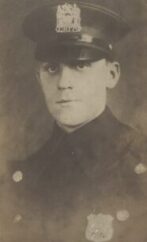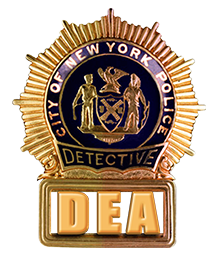The DEA Honor Roll
Official Line of Duty Deaths
James J. Garvey

Rank: Detective First Grade
Shield Number:
Command: 20 Detective Squad
Date of Death: 04/21/1934
Cause of Death: Shot and Killed in the Line of Duty
On April 21, 1934, Det. First Grade James J. Garvey was shot and killed by two gunmen at approximately 11:00 p.m. on Broadway and West 75th Street on the upper west side of Manhattan in the confines of the 20th Precinct. His partner, Det. Second Grade Francis G. Gleason, was shot in the chest and seriously wounded. He was transported to Roosevelt Hospital. A civilian bystander, Mrs. Florence Goldstein who lived on West 79th Street, was also wounded in the shooting, struck by bullets in the left leg. The gunmen fled.
Because of a recent rash of robberies and hold ups, the Detectives were assigned to a street patrol of the area. They had shadowed the two suspects for about 15 minutes, and when they started to approach for questioning, without warning, the gunmen pulled their weapons and opened fire.
Forty-five year old Garvey had served 21 years in the NYPD. He joined the force April 7, 1913, and earned his Detective’s gold shield on March 10, 1921. Before his long tenure at the 2-0, he had previously been assigned for many years to the stationhouse on West 135th Street (today, the 32 Precinct, but that historic stationhouse was built in 1937.) His mother Eliza was from County Clare, and his father County Cork in Ireland. Eliza immigrated to the United States in 1899, and moved in with a cousin on West 20th Street in Manhattan, presumably where Garvey grew up.
On April 25, 1934, Det. Garvey was given an elaborate “Inspector’s” police funeral attended by approximately 10,000 mourners at the Roman Catholic Church of St. Philip Neri on 200th Street in The Bronx, which was where he lived with his family at 2940 Grand Concourse. The Detective was survived by his wife, Pauline, and his 17-year-old daughter. It was reported in the 1934 New York Times that his widow’s pension amounted to one year of her husband’s salary, approximately $1,500, dispensed in a lump sum. She would then receive 50% of his salary each year of her life. She also received $5,000 from the Police Relief Fund in $50 installments. (After his death, his wife and daughter moved to 2227 Valentine Avenue in The Bronx. Addresses were routinely reported in the newspapers of that era.) Det. Garvey was buried at the Gate of Heaven Cemetery in Westchester, New York. His brother-in-law, Lt. John Becker, claimed that Garvey had a dream two months prior that foreshadowed his death.
At the time of the shooting, Garvey’s partner, Det. Gleason, was 38 years old. He joined the force in 1926 and was promoted to Detective in 1928. He was unmarried and lived with his mother and sister on East 92nd Street. He was able to describe the events that led to their shooting and give a description of the perpetrators. At least ten other civilian witnesses also observed the shootout.
In a later development, and near the location where Garvey and his partner were shot, a number of men and women were arrested with a possible connection to a bank robbery of a Prudential Savings located in Brooklyn. The gang of men and women hailed from the Detroit and Akron areas, and were caught transporting young women to New York, presumably for questionable purposes. They were staying at a Hotel Kimberly near where the Garvey shooting took place, on the upper west side of Manhattan, but police later dismissed them as having any connection to the shoot-out with the Detectives. A Citywide manhunt continued for the gunmen. The Times reported that Detectives were visiting known “gangster haunts,” but came up empty-handed.
But, eight years later, it took a jury less than one hour to pronounce Joseph Sonsky, a 32-year-old convict, guilty of slaying Det. Garvey. Sonsky was already serving a 30 years-to-life sentence in Great Meadows Penitentiary for a hold-up in Garden Place, Brooklyn, in which another Police Officer, John Monaghan, was killed. Evidence presented at Sonsky’s trial included information that Sonsky and another gangster, Norman Zepp, were waiting at the intersection of Broadway and 74th Street on April 21, 1934, in order to shoot and kill a third gangster, Hymie Halperin. But, Halperin never showed, so Zepp and Sonsky, “decided to pull some” other hold-ups. But, Gleason and Garvey came along. The gangsters opened fire at the Detectives, and then fled.
Later, when Zepp was serving a long, unrelated term at Sing Sing, he tried to escape while being transported. Police shot and mortally wounded him, but he made a deathbed confession about the Garvey shooting. He said he was hired to hit Halperin for $500 on the day they shot the Detectives. When their intended victims didn’t show, and they decided to rob a few stores, it was when Gleason and Garvey approached them. After Zepp confessed and expired, Sonsky was arrested, tried, and was sentenced to die in the electric chair at Sing Sing. He was executed on January 14, 1943.
As for the immensely popular Det. Garvey, members of the NYPD pooled their money and financed the higher education of his daughter Helen, who was a freshman in college when her father was killed. At 20 years of age, she was able to graduate New York University. She had been stricken as a child with infant paralysis, was partially infirmed and wore a brace on her leg; and it was reported to be one of her father’s “fondest dreams to have his only daughter graduate college.” To raise the funds, the Officers held a benefit at the Beacon Theatre on Broadway in the confines of the 2-0. Helen Garvey was quoted in The New York Times on May 13, 1937, as expressing her deepest gratitude to those members of the service who “made her graduation a reality.”
Read more about Det. Garvey on the following pdf link below, which contains the articles: “Broadway Gunmen Kill a Detective, Wound 2 Others,” NY Times, 4/22/34; “Detective Killers identified By Ten,” NY Times, 4/23/1934; “City Police Mourn Detective Garvey,” NY Times, 4/26/34; “Convicted of Murder of Detective in 1934,” NY Times, 4/16/42; “Detective’s Slayer Sentenced to Death,” NY Times, 5/16/42; “Sileo, Sonsky Go to Chair,” NY Times, 1/15/43.
Det. Garvey Composite Articles, NY Times 1934-1943
